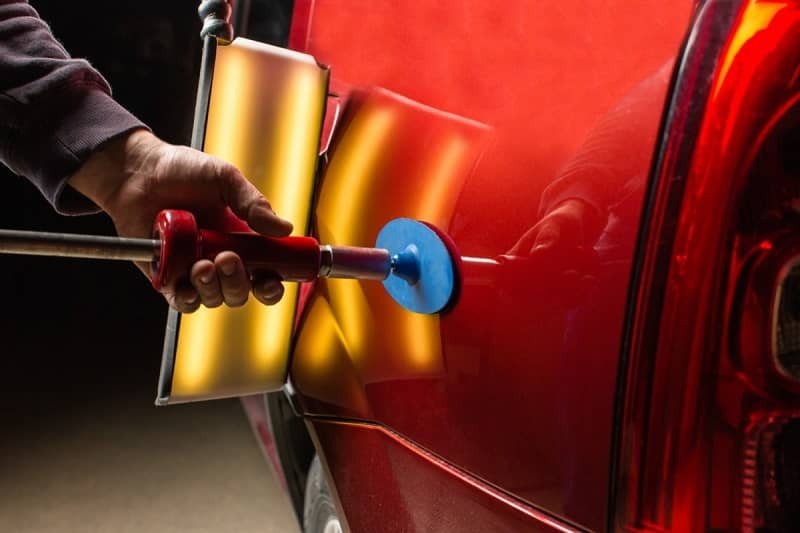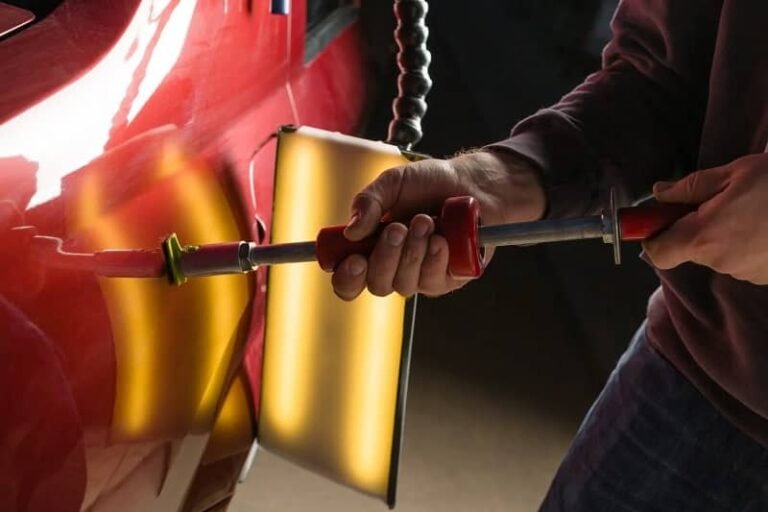Paintless Dent Repair vs Traditional Dent Repair
Paintless dent repair (PDR) stands in stark contrast to traditional dent repair methods, offering a unique and innovative approach to restoring a vehicle’s aesthetic appeal. In the realm of conventional dent repair, the process typically involves the application of body filler to the damaged area, followed by sanding and repainting to achieve a seamless finish. On the other hand, paintless dent repair introduces a revolutionary technique that deviates from the traditional path. This is a vital fact about paintless dent repair vs traditional dent repair.
In essence, the fundamental distinction (Paintless Dent Repair vs Traditional Dent Repair) lies in the methodology employed to address dents. Unlike the use of body filler and subsequent refinishing in traditional dent repair, paintless dent repair involves a more intricate and non-invasive procedure. The skilled technician proficient in PDR doesn’t resort to conventional fillers or paint touch-ups; instead, they leverage a specialized set of tools and techniques designed to manipulate the metal from behind the damaged panel.
The process begins with a meticulous examination of the dent’s location and size, assessing whether it is a suitable candidate for paintless dent repair. Generally, PDR is most effective for smaller dents and dings where the paint has not sustained significant damage. Once the viability is determined, the technician gains access to the backside of the dent, whether through existing access points or by temporarily removing body panels or interior components.
The key advantage of paintless dent repair lies in its ability to preserve the vehicle’s original factory finish. Traditional dent repair often entails blending and repainting entire panels, which can result in color discrepancies and diminish the overall aesthetic appeal of the vehicle. Paintless dent repair eliminates the need for extensive repainting, ensuring that the repaired area seamlessly integrates with the surrounding untouched paint.

The specialized tools employed in PDR (paint less dent repair or – paintless dent repair) vary, ranging from metal rods of different shapes and sizes to specialized tabs and pullers. The technician carefully manipulates these tools to massage the metal back into its original form, effectively eliminating the dent without compromising the paint finish. The precision and skill required in this process make paintless dent repair both an art and a science, demanding a keen eye and expert touch.
Moreover, paintless dent repair offers a more time-efficient solution compared to traditional methods. The absence of time-consuming steps like sanding, filling, and repainting streamlines the process, allowing for quicker turnaround times. Vehicle owners can benefit from expedited repairs without sacrificing quality, making paintless dent repair an attractive option for those seeking both efficiency and excellence.
Another noteworthy aspect of PDR is its environmentally friendly nature. Traditional dent repair often involves the use of body fillers and paints that emit volatile organic compounds (VOCs), contributing to environmental pollution. In contrast, paintless dent repair minimizes the need for such materials, aligning with contemporary eco-conscious practices.
It’s essential to acknowledge the limitations of paintless dent repair. While highly effective for smaller dents and dings, PDR may not be suitable for more extensive damage or situations where the paint has chipped or cracked. In such cases, traditional repair methods might be necessary to achieve comprehensive restoration. Speaking of paintless dent repair vs traditional dent repair this is one of the drawbacks.
In conclusion, in terms of paintless dent repair vs traditional dent repair vs. paintless dent repair (PDR) emerges as a revolutionary method for effectively addressing vehicle dents, presenting numerous advantages that surpass traditional repair approaches. Its ability to preserve the original paint finish sets it apart, ensuring a seamless restoration without compromising the vehicle’s aesthetic appeal.
Moreover, PDR boasts expedited turnaround times, allowing vehicle owners to regain their pristine appearance swiftly. The eco-friendliness of PDR aligns with the growing emphasis on environmental responsibility, making it an attractive choice for conscientious vehicle owners. As the automotive industry continues to evolve, paintless dent repair stands as a testament to the successful fusion of cutting-edge technology and skilled craftsmanship, offering a holistic solution for dent removal needs.

